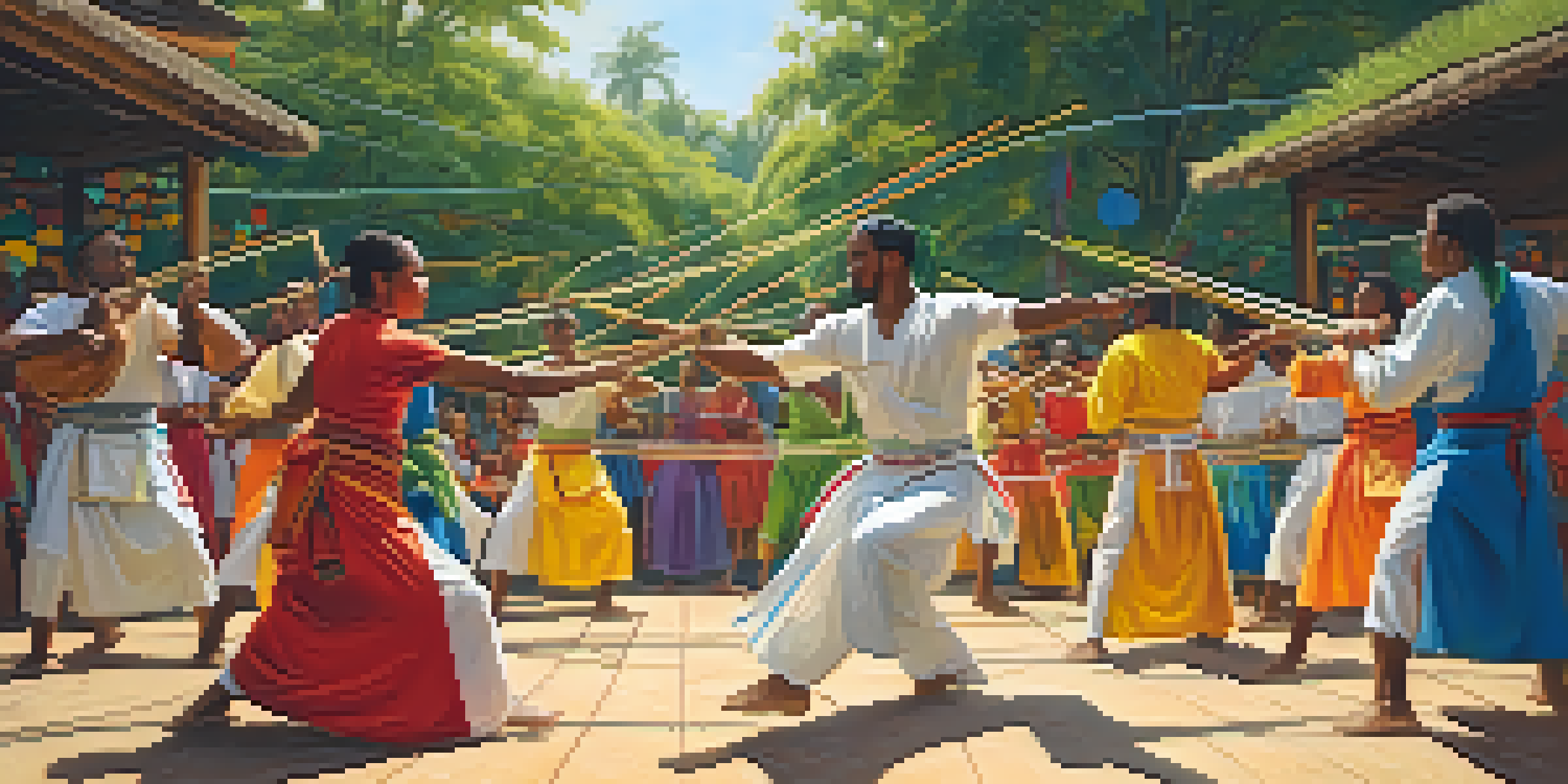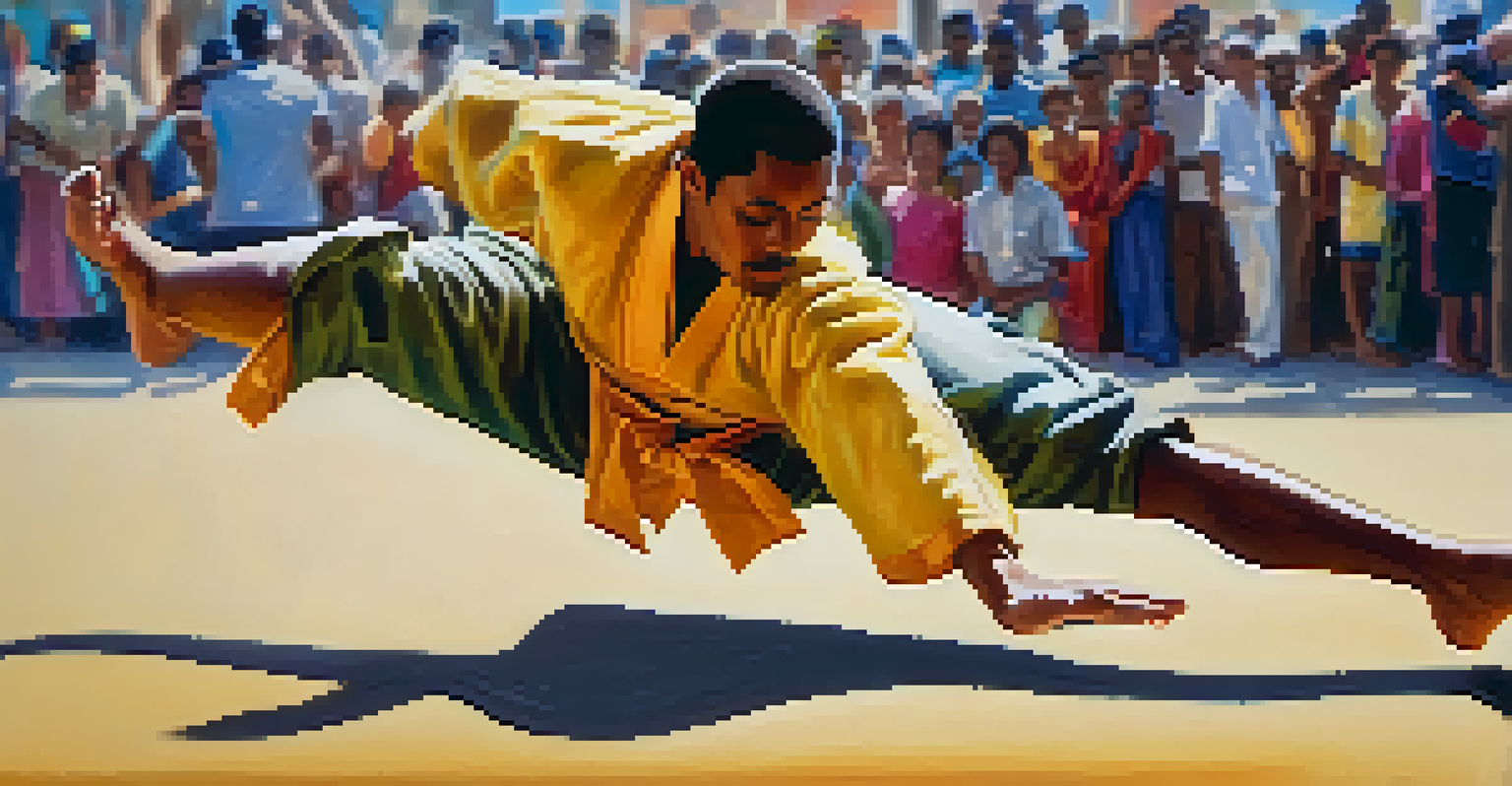Capoeira: The Fusion of Dance, Martial Arts, and Cultural Identity

What is Capoeira? Understanding Its Origins and Essence
Capoeira is a Brazilian martial art that combines elements of dance, acrobatics, and music, creating a captivating display of movement and rhythm. This art form emerged in the 16th century among African slaves in Brazil as a means of self-defense disguised as dance. Over time, it evolved into a rich cultural expression, reflecting the struggles and resilience of its practitioners.
Capoeira is a dance that fights and a fight that dances.
At its core, Capoeira is characterized by its fluid, circular movements and the unique ginga, or swaying motion, which keeps practitioners in constant motion. The art form often takes place in a circle called a 'roda,' where participants engage in a dance-like combat, showcasing their skills and creativity. The rhythmic accompaniment of traditional instruments and songs adds to the vibrant atmosphere, making Capoeira a true spectacle.
More than just a physical activity, Capoeira embodies a cultural identity that connects its practitioners to their history. It serves as a celebration of African heritage, promoting values such as community, respect, and freedom. Through its dynamic interplay of art and combat, Capoeira continues to inspire and unite people from diverse backgrounds.
The Dance and Martial Arts Fusion: A Unique Experience
One of the most intriguing aspects of Capoeira is how it seamlessly fuses dance and martial arts. The graceful movements and acrobatic flips resemble a dance performance, while the strategic kicks and dodges exhibit martial prowess. This duality creates a captivating experience that engages both participants and spectators alike.

In a typical roda, the energy flows back and forth as players take turns showcasing their skills. Each movement is a dialogue expressed through body language, allowing practitioners to communicate and respond to one another creatively. This playful interaction fosters an environment of mutual respect and camaraderie, setting Capoeira apart from traditional martial arts.
Capoeira: Culture and History
Capoeira is a Brazilian martial art that blends dance, acrobatics, and music, rooted in the resistance and resilience of enslaved Africans.
Moreover, the incorporation of music is vital in this fusion. Songs sung during the roda not only provide rhythm but also tell stories that celebrate the history and spirit of Capoeira. This combination of movement, music, and interaction makes Capoeira a holistic experience that transcends boundaries, connecting people through shared expression.
Cultural Identity: Capoeira as a Symbol of Resistance
Capoeira is not merely a physical practice; it represents a powerful cultural identity rooted in resistance and survival. Originating in the context of slavery, it served as a means for enslaved Africans to reclaim their agency and express their culture in a society that sought to suppress them. This historical significance remains a cornerstone of Capoeira's identity today.
In Capoeira, the movement speaks for itself; it tells a story beyond words.
As practitioners engage in Capoeira, they not only learn the art form but also immerse themselves in its rich history and cultural narratives. This connection to the past instills a sense of pride and belonging, reinforcing the idea that Capoeira is a living testament to resilience and strength. It empowers individuals to embrace their heritage while also fostering unity across diverse communities.
Today, Capoeira continues to evolve, transcending geographical and cultural boundaries. It has become a global phenomenon, with practitioners from all walks of life joining the roda. Through this expansion, Capoeira serves as a bridge, connecting people from different backgrounds and creating a shared sense of identity and purpose.
The Role of Music in Capoeira: A Soulful Connection
Music plays an essential role in the practice of Capoeira, setting the rhythm and tone for the movements. Traditional instruments, such as the berimbau, atabaque, and pandeiro, create a distinctive soundscape that guides the flow of the roda. The songs sung during Capoeira sessions often tell stories of struggle, joy, and cultural pride, further enriching the experience.
As the music fills the air, practitioners are encouraged to express themselves through their movements, responding to the beats and melodies. This connection to music not only enhances the physical practice but also fosters a deeper emotional engagement. It's as if the body and music work in harmony, creating a unique dialogue that resonates with everyone present.
Health Benefits of Capoeira
Practicing Capoeira enhances physical fitness, mental well-being, and fosters social connections among participants.
Moreover, the communal aspect of music in Capoeira strengthens bonds among practitioners. Whether singing together or playing instruments, participants share a sense of belonging and collective identity. This musical foundation transforms Capoeira into a celebration of culture and community, making it a truly special experience for all involved.
Capoeira Today: A Global Movement for All
In recent years, Capoeira has gained popularity worldwide, attracting practitioners from various backgrounds and age groups. Classes and workshops are now offered in countless countries, allowing individuals to experience the art form's unique blend of movement, music, and culture. This global expansion highlights Capoeira's universal appeal and adaptability.
With its inclusive nature, Capoeira welcomes anyone interested in learning, regardless of skill level or background. From beginners to advanced practitioners, everyone can participate in the roda, promoting a sense of community and shared learning. This accessibility is one of the reasons Capoeira continues to thrive and evolve as a global movement.
As more people engage with Capoeira, the art form is also diversifying, integrating various influences and styles. This evolution reflects the dynamic nature of Capoeira, ensuring that it remains relevant and resonant in today's world. Ultimately, Capoeira stands as a testament to the power of cultural expression, uniting individuals through a shared passion for movement and identity.
Health Benefits of Practicing Capoeira: Mind and Body
Practicing Capoeira offers a multitude of health benefits that extend beyond physical fitness. The combination of dance, acrobatics, and martial arts provides a full-body workout, improving strength, flexibility, and coordination. Regular participation can lead to enhanced cardiovascular health, as the dynamic movements elevate the heart rate and promote overall well-being.
Moreover, Capoeira is not just about physicality; it also nurtures mental health. The focus required to learn and perform movements enhances concentration and mindfulness. Engaging in Capoeira can serve as a form of stress relief, allowing practitioners to immerse themselves in the rhythm and flow, leaving behind daily worries.
Global Appeal of Capoeira
Capoeira's inclusive nature and adaptability have led to its widespread popularity, welcoming practitioners from diverse backgrounds worldwide.
The social aspect of Capoeira further contributes to its health benefits. Practicing in a group fosters camaraderie and support, creating a sense of belonging that can be uplifting. This combination of physical activity, mental engagement, and social connection makes Capoeira a holistic practice that nurtures both body and mind.
Getting Started with Capoeira: Tips for Beginners
If you're intrigued by the vibrant world of Capoeira and want to give it a try, starting your journey is easier than you might think. Look for local Capoeira schools or classes in your area, where you can learn from experienced instructors. Many schools offer introductory sessions specifically designed for beginners, ensuring a welcoming environment for newcomers.
When starting, keep an open mind and embrace the learning process. Capoeira is not just about mastering techniques; it's also about connecting with others and enjoying the experience. Don't be afraid to ask questions or seek guidance from more experienced practitioners, as they can provide valuable insights and support.

Lastly, remember that Capoeira is as much about the journey as it is about the destination. Celebrate your progress, no matter how small, and immerse yourself in the culture, music, and community that surrounds this incredible art form. With patience and enthusiasm, you'll find yourself not only honing your skills but also becoming part of a vibrant global family.